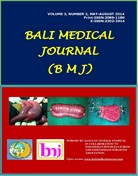OBSTRUCTIVE NEPHROPATHY OF KIDNEY STONE: The Role of Caspase-3, Transforming Growth Factor-? and Tumor Necrosis Factor-? in Kidney Fibrosis
Abstract
Objective: Kidney stones are one of the causes of obstructive nephropathy and chronic kidney disease (CKD), characterized by the presence of hydronephrosis and kidney dysfunction. The histhopathologycharacteristics of CKD is kidney fibrosis, which consists of glomerulosclerosis (GS), tubulointerstitial fibrosis (TIF) and tubular atrophia (TA).This research aims to find out that the role of caspase-3, TGF-? and TNF-? as risk factors for kidney fibrosis in obstructive nephropathy of kidney stone. Methode: A total of 82 samples of kidney biopsy patientsduring kidney stone surgery in Sanglah General Hospital Denpasar-Bali from February until December 2013 wereapplied match paired based on age and sex divided in to 41 samples as case and 41 samples as control. Determination of caspase-3, TNF-? and TGF-?1 were carried out using Kit Methode and kidney fibrosis stained with Masson's Trichrome. Results: Bivariate analysis test indicates that OR caspase-3 activity and kidney fibrosis were 3.50; 95%CI (2.95-4.19); p=0.001, OR levels of TGF-? an kidney fibrosis were 2.00; 95% CI (1.72-2.34); p=0.04 andOR levels of TNF ? and kidney fibrosis were 0.60; 95% CI (0.53-0.68); p=0.14. On the other hand, multivariate analysis test OR for caspase-3 activity , levels of TGF-?, levels of TNF-? and kidney fibrosis after adjustment of hydronephrosis, eLFG, and Hb were 2.43; 95% CI (0.86 – 6.90); p=0.09, 2.14; 95% CI (0.74-6.18) p=0.16 and 1.12; 95% CI (0.40-3.16); p=0.82. Conclusion: In obstructive nephropathy of kidney stone patients with high activity of caspase-3 have 3.5 fold risk to gain kidney fibrosis and with high levels of TGF-? have a 2 fold risk to gain kidney fibrosis. However, high levels of TNF-? was not as a risk factor to gain kidney fibrosis. These results can be used as a based data to run further research for obtaining new strategy for managing kidney fibrosis.


